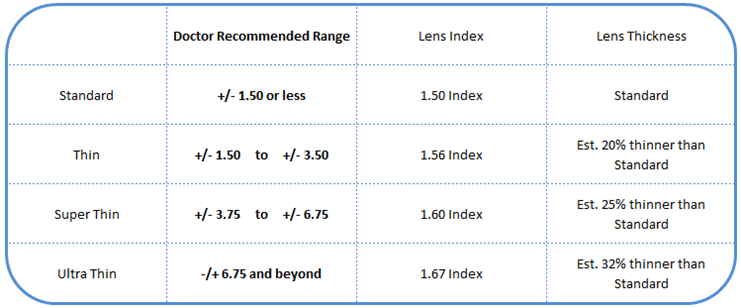Lenses and Coating
|
Lenses Single Vision Single vision lenses have one fixed focus point over the entire lens. They are the standard eyeglass prescription and are used for distant (everyday use), near (reading use) or intermediate vision (computer use). Progressive Progressive lenses are multi focal lenses that are designed for both distant and reading uses. These lenses have multiple fields of vision, providing smooth transition from distant vision (at the top of the lens), intermediate vision (in the middle of the lens) to near vision (at the bottom of the lens). They do not have a line and are similar in appearance to single vision lenses. It is common to take weeks or even up to a month to fully adapt to progressive lenses (or even just a new prescription). The key is to give your eyes a chance to get used to them, by wearing them constantly. Clear-to-Dark Take your Clear-to-Dark lenses from the indoor to the outdoor! Clear-to-Dark lenses are photochromic lenses that adapt to varying light conditions and darken with exposure to UV rays. They are ideal for multi-purpose usage (indoor + outdoor) and also provide sun protection. Lens Thickness Look up your lens type (Standard, Thin, Super Thin, or Ultra Thin) based on doctor recommendations:
Coatings Scratch Resistant (or Anti Scratch) Scratch resistant coating minimizes the occurrences of minor scratches on the surface and improves the durability of the lenses. AR (Anti-Reflection) Anti-reflection coating improves the light transmission through the lenses. This coating provides both functional and cosmetic enhancements to the lenses. Functionally, AR coating improves the vision by reducing the amount of light reflected. AR coating works to reduce glare and halos around lights and is critically important for driving at night. Similarly, they are highly recommended for those who spend significant amount of time in front of a computer, as they lessen glare from computer screen and therefore reduce eye strain. Cosmetically, AR coating reduces both the internal and external reflections. By reducing external reflections, people see your eyes instead of the glare on your glasses (and in photos too!). By reducing internal reflections, lenses have a thinner appearance and are esthetically optimized. To check that your lenses have AR coating, inspect your glasses in good lighting. At an angle, lenses with AR coating give a very slight green, blue or purple sheen. UV Protection UV coating on lenses blocks out harmful UV rays. They work the same way as sun block do for your skin. Excessive exposure to UV rays may cause cataracts, retinal damage and other problems. |
|
|





